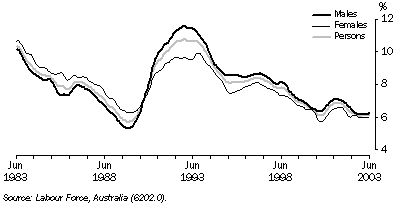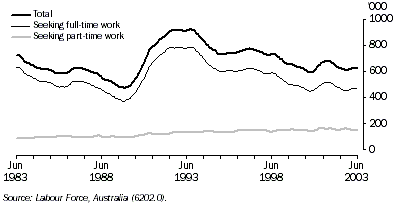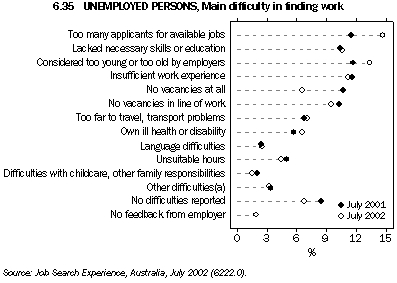|
|
In the Labour Force Survey, people are considered to be unemployed if they satisfy three criteria: they are not employed; they are available for work; and they are taking active steps to find work.
Two important measures of unemployment are the number of persons unemployed and the unemployment rate. The unemployment rate, defined as the number of unemployed persons expressed as a percentage of the labour force, offers an insight into the degree of slack in the labour market.
Movements in the unemployment rate over the past 20 years are dominated by the recessions of the early-1980s and early-1990s, and the subsequent periods of economic recovery (graph 6.31). In trend terms, the unemployment rate peaked at 10.7% in December 1992, then generally fell over the rest of the 1990s, to stand at 6.1% in June 2003.
Historically, the unemployment rate for males has been lower than for females. However, just prior to the recession of the early-1990s, when unemployment increased dramatically, the male unemployment rate increased to a level above the female unemployment rate, and has remained higher ever since.
6.31 UNEMPLOYMENT RATE: Trend estimates

As graph 6.32 shows, unemployment has generally declined from the levels recorded during the last recession. For the unemployed seeking full-time work, the trend generally reflected the overall impact of the economic cycle. In contrast, over the last two decades or more, the trend for those seeking part-time work, while rising more strongly in the course of a recession, has more generally continued to increase, rising from 89,700 persons (or 12% of unemployed persons) in 1983 to 147,700 persons (or 24% of unemployed persons) in 2003.
6.32 UNEMPLOYED PERSONS: Trend estimates

In recent years, the proportion of the unemployed who had experienced unemployment for 26 weeks or less has been rising steadily, while the proportion who experienced unemployment for 52 weeks and over (long-term unemployment) has been in decline. In 2002-03, 64.0% of unemployed persons had been unemployed for less than 26 weeks, while the long-term unemployed made up 22.1% of unemployment (table 6.33).
6.33 UNEMPLOYED PERSONS(a)(b), By duration of unemployment
|
| Weeks | Units | 1997-98 | 1998-99 | 1999-2000 | 2000-01 | 2001-02 | 2002-03 |
|
| Under 8 | % | 27.9 | 29.8 | 34.0 | 35.8 | 35.0 | 36.1 |
| 8 to under 26 | % | 23.9 | 23.3 | 23.6 | 25.7 | 28.3 | 27.9 |
| Under 26 | % | 51.8 | 53.1 | 57.6 | 61.5 | 63.3 | 64.0 |
| 26 to under 52 | % | 16.6 | 14.9 | 13.8 | 13.9 | 14.3 | 13.9 |
| 52 to under 104 | % | 14.5 | 13.4 | 10.8 | 9.7 | 9.0 | 9.1 |
| 104 and over | % | 17.2 | 18.5 | 17.9 | 14.9 | 13.4 | 13.0 |
| 52 and over | % | 31.7 | 31.9 | 28.7 | 24.6 | 22.4 | 22.1 |
| Total | % | 100.0 | 100.0 | 100.0 | 100.0 | 100.0 | 100.0 |
| Number | '000 | 764.2 | 718.2 | 661.4 | 647.7 | 656.8 | 616.3 |
|
(a) Annual averages.
(b) Data have not been revised to reflect definitional changes introduced in April 2001. Data collected from April 2001 onwards are not strictly comparable with data collected in earlier periods. For further information, see 'Information Paper: Implementing the Redesigned Labour Force Survey Questionnaire' (6295.0). |
 |  |  |  |  |  |  |  |
| Source: ABS data available on request, Labour Force Survey. |
Educational qualifications have a significant bearing on labour market prospects. Table 6.34 shows the relationship between the level of highest educational attainment and duration of unemployment. Of unemployed persons with a bachelor degree or above in July 2002, 15.7% were long-term unemployed, compared to 31.7% of those who had completed Year 10 or below.
6.34 UNEMPLOYED PERSONS, Educational attainment(a) and duration of unemployment - July 2002
|
 |  |  | Duration of current period of unemployment (weeks) |  |  |
 |  |  |
|  |  |
| Level of highest educational attainment | Units |  | 1 to
under 8 | 8 to
under 26 | 26 to
under 52 | 52 to
under 104 | 104 and
over | Total(b) | Number(b) |
|
| Bachelor degree or above | % |  | 41.0 | 33.8 | *9.5 | *5.1 | *10.5 | 100.0 | 47.7 |
| Advanced diploma or diploma | % |  | 35.6 | 29.6 | *8.6 | *14.0 | *12.3 | 100.0 | 31.5 |
| Certificate III / IV | % |  | 26.4 | 35.5 | 13.0 | 14.6 | 10.7 | 100.0 | 65.5 |
| Certificate I / II | % |  | *21.0 | *20.6 | *19.8 | *20.3 | *18.3 | 100.0 | 10.4 |
| Certificate not further defined | % |  | **18.4 | **16.7 | **25.8 | **22.1 | **17.0 | 100.0 | *1.7 |
| Year 12(c) | % |  | 37.4 | 25.2 | 15.8 | 9.8 | 11.7 | 100.0 | 123.0 |
| Year 11(c) | % |  | 32.0 | 30.5 | 15.4 | 10.2 | 11.9 | 100.0 | 57.6 |
| Year 10 or below(c) | % |  | 26.9 | 25.6 | 15.9 | 12.9 | 18.8 | 100.0 | 214.0 |
| All unemployed persons | '000 |  | 173.5 | 154.7 | 80.9 | 65.1 | 80.7 | - | 554.8 |
|
(a) The levels of education are not necessarily listed in order from highest to lowest. See paragraphs 15-17 of the Explanatory Notes in 'Education and Work, Australia' (6227.0) for further details on how level of highest educational attainment is determined.
(b) Includes no educational attainment, and level not determined.
(c) Includes persons who are currently undertaking school study. |
 |  |  |  |  |  |  |  |  |  |
| Source: Job Search Experience, Australia, July 2002 (6222.0). |
Unemployed persons may encounter a variety of difficulties in finding work, as shown in graph 6.35 and table 6.36. In the July 2002 survey, the most commonly reported main difficulties in finding work were 'Too many applicants for available jobs' (14.7% compared with 11.5% in 2001), 'Considered too young or too old by employers' (13.4% compared with 11.7% in 2001), 'Insufficient work experience' (11.2%, compared with 11.6% in 2001). Those reporting 'No vacancies at all' fell from 10.7% of the unemployed in July 2001 to 6.6% in July 2002.

6.36 UNEMPLOYED PERSONS, Main difficulty in finding work - July 2002
|
 | Units | Males | Females | Persons |
|
| Too many applicants for available jobs | % | 14.6 | 14.8 | 14.7 |
| Lacked necessary skills or education | % | 10.6 | 10.5 | 10.6 |
| Considered too young or too old by employers | % | 13.1 | 13.7 | 13.4 |
| Insufficient work experience | % | 10.0 | 12.8 | 11.2 |
| No vacancies at all | % | 7.4 | 5.5 | 6.6 |
| No vacancies in line of work | % | 11.6 | 6.7 | 9.5 |
| Too far to travel, transport problems | % | 7.8 | 6.3 | 7.1 |
| Own ill health or disability | % | 8.4 | 4.2 | 6.6 |
| Language difficulties | % | 2.4 | 2.8 | 2.5 |
| Unsuitable hours | % | 1.8 | 8.0 | 4.4 |
| Difficulties with childcare, other family responsibilities |
%
|
*0.8
|
2.3
|
1.5
|
| Other difficulties(a) | % | 2.9 | 3.6 | 3.2 |
| No difficulties reported | % | 7.2 | 6.4 | 6.8 |
| No feedback from employer | % | *1.5 | 2.5 | 1.9 |
| Total | % | 100.0 | 100.0 | 100.0 |
| Number | '000 | 319.1 | 235.7 | 554.8 |
|
| (a) Includes persons who reported difficulties because of ethnic background. |
 |
| Source: Job Search Experience, Australia, July 2002 (6222.0). |
|
 Print Page
Print Page